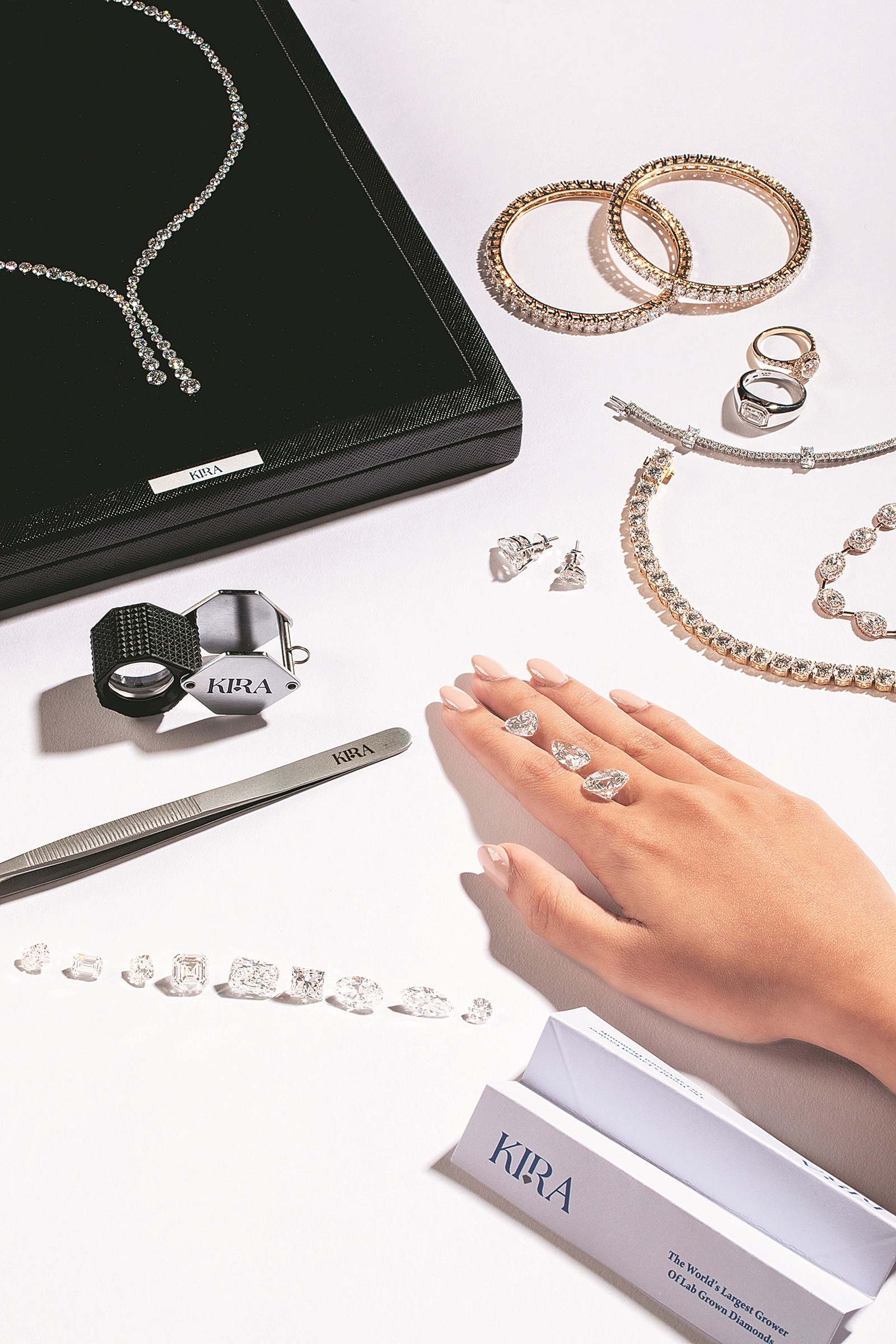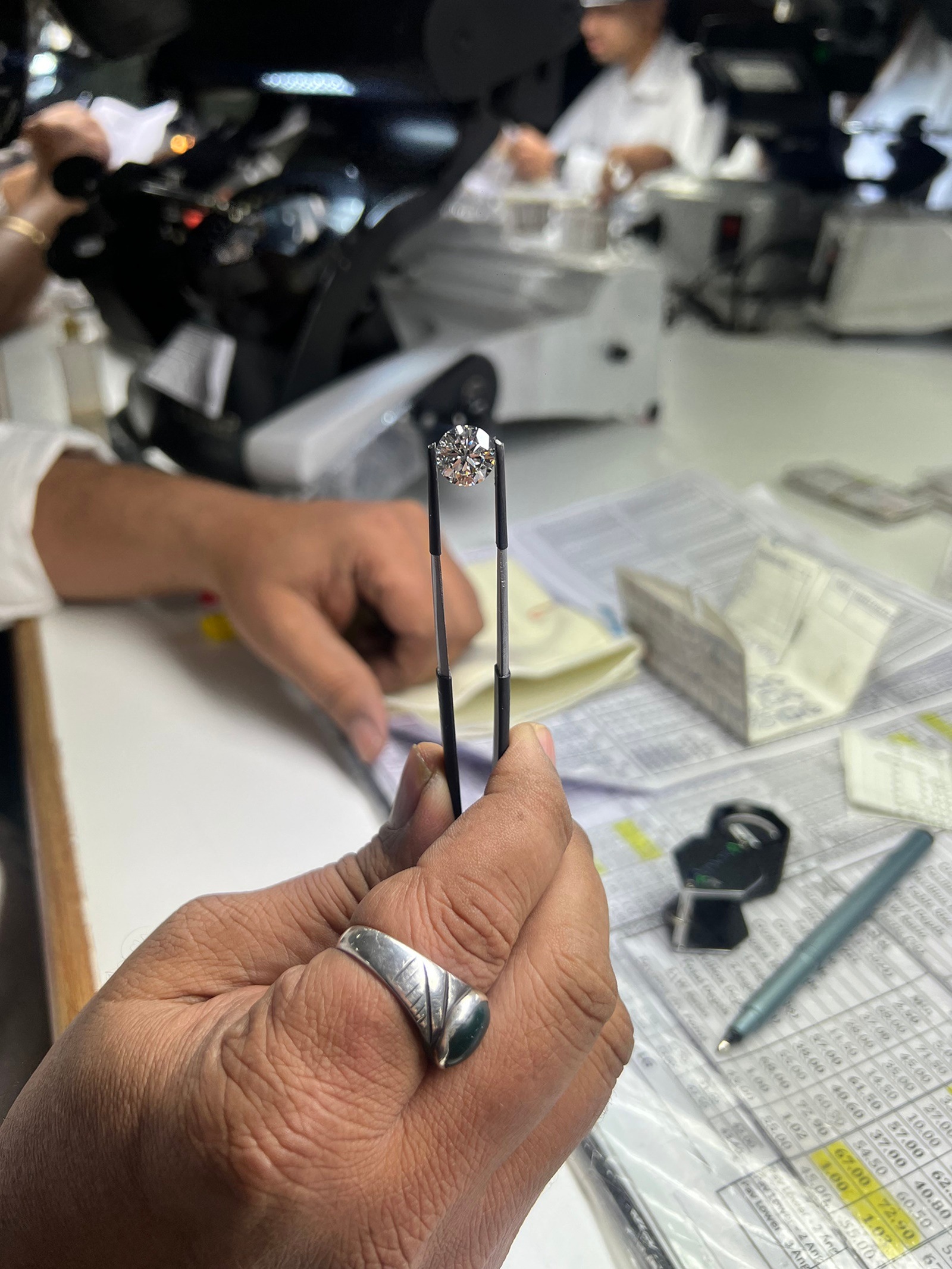Younger Indians are choosing lab-grown diamonds over mined ones
As consumers the world over are going for lab-grown diamonds, their popularity looks set to rise in India, despite a recent price slump
 An exhibit of LGD jewellery at the International Jewellery Show (IIJS) in Mumbai (Courtesy: Pradip Das)
An exhibit of LGD jewellery at the International Jewellery Show (IIJS) in Mumbai (Courtesy: Pradip Das)Earlier this year, Mumbai-based Aashi Sottany was introduced to lab-grown diamonds (LGD) by a friend who sells jewellery made from them. “It’s exactly like a diamond—it has the same shine, look, and feel, and it’s much cheaper than a natural diamond,” says the 26-year-old PR professional. She recently bought a pendant set with a pair of earrings, each featuring half-a-carat of LGD, and a one-carat diamond ring. “It’s my engagement ring. I suggested this idea to my now fiancé, and he loved it. I also bought him an LGD ring, so we saved a lot of money,” she adds. Her ring cost about Rs 30,000, and the pendant set, which her parents bought as part of her wedding trousseau, cost Rs 36,000.
Sottany is one of an increasing tribe of consumers drawn to LGDs. According to Future Market Insights, the lab-grown diamond jewellery market was valued at $264.5 million in 2022 and is expected to grow at a 14.8 per cent CAGR over the next decade, potentially reaching $1.19 billion by 2033.
Known by various names over the years—from synthetic to man-made and lab-grown—these diamonds are not mined but grown in a reactor using a thin slice of high-quality diamond that serves as a seed for growing LGD. “Diamonds need specific temperatures, environments, and gases to grow. We replicate these conditions inside the reactor, exposing the seeds to carbon-rich gases and carbon deposits. The process mimics natural conditions but occurs in a much shorter time frame,” explains Smit Patel of Greenlab Diamonds, a leading player in the industry since 2017. Patel uses the Chemical Vapour Deposition (CVD) method, producing CVD diamonds.
LGDs have the same physical appearance and chemical composition as natural diamonds and cannot be distinguished by the naked eye. “We ourselves have been diamond tiers for 60 years. My grandfather came to Surat with nothing and started cutting and polishing with one wheel. When we showed him our first lab-grown diamond in 2017, he asked me, ‘Which mine has it come from?’ He couldn’t tell the difference because there is none. We saw a future in LGDs and fully shifted our focus,” adds Patel.
 LGD jewellery designs (Courtesy: Kira Diam)
LGD jewellery designs (Courtesy: Kira Diam)
While some say there’s no definitive figure on the number of carats a machine can produce, Kira Diam, founded a year-and-a-half ago, prides itself on being one of the largest manufacturers and producers, accounting for 25 per cent of India’s production. “We have a 700,000-sq ft facility in Surat with 2,500 machines and produce approximately 150,000 carats of polished diamonds per month,” says Shanay Parekh, partner at Kira Diam. The transformation cycle from seeds to diamonds takes about 25-30 days, followed by 45 days of cutting and polishing, done by the same experts in Surat.
Similarly, Surat’s Vaghasiya family, who has traded natural diamonds for over twenty years, began exploring LGDs four years ago. “My father and his brothers started with buying loose natural diamonds, and my cousins and I followed. We noticed the growth of LGDs and saw it as a lucrative business opportunity, so we transitioned fully to LGDs. The margins were substantial at that time,” says 38-year-old Satish Vaghasiya, who showcased his diamonds at the India International Jewellery Show (IIJS) in Mumbai.
The spike and the fall
The demand for lab-grown diamonds surged during the COVID-19 pandemic, particularly in 2020-21, according to Anshul Doshi of Bijoux Fine Jewellery, a Zaveri Bazaar-based jewellery designer and manufacturer. “This spike was driven by millennials, who have seen their mothers and mothers-in-law’s jewellery mostly sitting in bank lockers, and by Gen Z, who prefer spending on experiences like travel or investment options rather than on expensive jewellery. However, the trend wasn’t limited to younger generations,” he explains. The increased demand led to higher prices and substantial margins, which attracted more players into the market. This influx resulted in an oversupply, causing a subsequent price drop.
A recent report from the Global Trade Research Initiative (GTRI) revealed that prices have plummeted by 65 per cent over the past year, from Rs 60,000 to Rs 20,000 per carat, due to local overproduction and oversupply from abroad. The report estimates that the number of LGD production units has risen to 10,000.
Most designers, manufacturers, and growers agree that prices have dropped significantly but say while they experienced losses on inventory, these were offset by profits made in earlier years.
“It’s a price correction,” Patel notes. “We anticipated this because the industry is still new. On average, growth has been 400 per cent, and although prices have corrected, the volume of exports has continued to increase.”
 A polished LGD (Courtesy: Kira Diam)
A polished LGD (Courtesy: Kira Diam)
“There is no control over production, leading to a supply that exceeds demand. Additionally, as a technology-based product, prices tend to fall over time, as seen with similar products in the past. This creates hesitation among sellers to keep inventory,” says Vipul Shah, Chairman of the Gem and Jewellery Export Promotion Council (GJEPC).
Despite India being one of the leading producers of lab-grown diamonds, the largest consumer market remains the United States. Domestically, LGDs are yet to solidify their position. “Until last year, we had no presence at IIJS,” reveals Patel.
Parekh admits that they are encountering resistance from Indian retailers. “Many retailers have a stake in the natural diamond business or hold significant inventory… However, this resistance is gradually decreasing, and within the next 12 months, LGDs are expected to be available at leading retail jewellery stores,” he says.
The decline in prices has also been a deterrent for some customers. “People want to look good in jewellery but also view it as an investment. Since LGDs lack resale value, many from the older generation—who have traditionally upgraded their diamonds—find this a drawback,” notes Anshul Doshi.
“Diamonds, whether lab-grown or natural, are not ideal investments. The allure of diamonds has been heavily marketed by companies like De Beers, but unlike gold, diamonds do not guarantee a price increase,” says Disha Shah of DiAi Design, adding that the conversation around LGDs often focuses on price rather than the design possibilities they offer. “With LGDs, we can create custom shapes like butterflies or clouds, which would be prohibitively expensive with natural diamonds due to high losses. The younger generation is also drawn to LGDs for their sustainability and the fact that they are ‘blood-free’—they are not mined, thus avoiding the human rights abuses and child labour associated with traditional diamond mining,” Shah concludes.
Parekh is optimistic about the future of lab-grown diamonds. “Natural diamonds are affordable only to a small percentage of the population, roughly the top one per cent. Lab-grown diamonds, however, cater to the next 15-20 per cent of consumers. The current challenge is a lack of awareness. But once we overcome this, we can expect to see a similar trend to what’s happened in the US, where LGDs now account for 60 per cent of the market,” he says.
- 01
- 02
- 03
- 04
- 05































